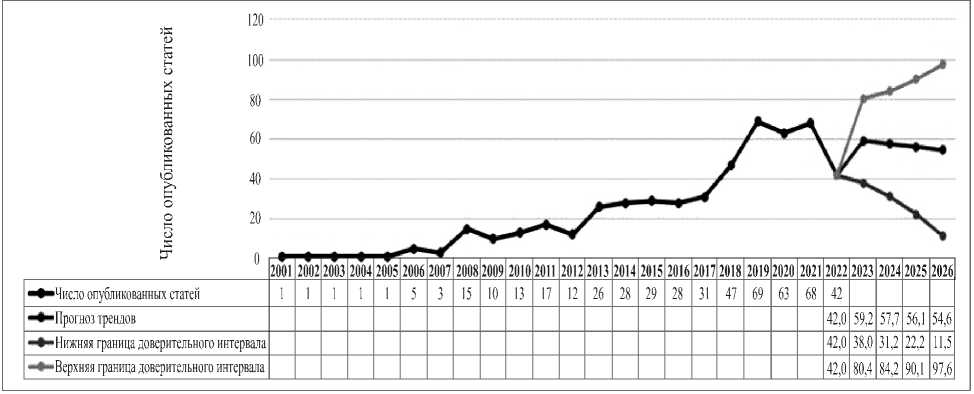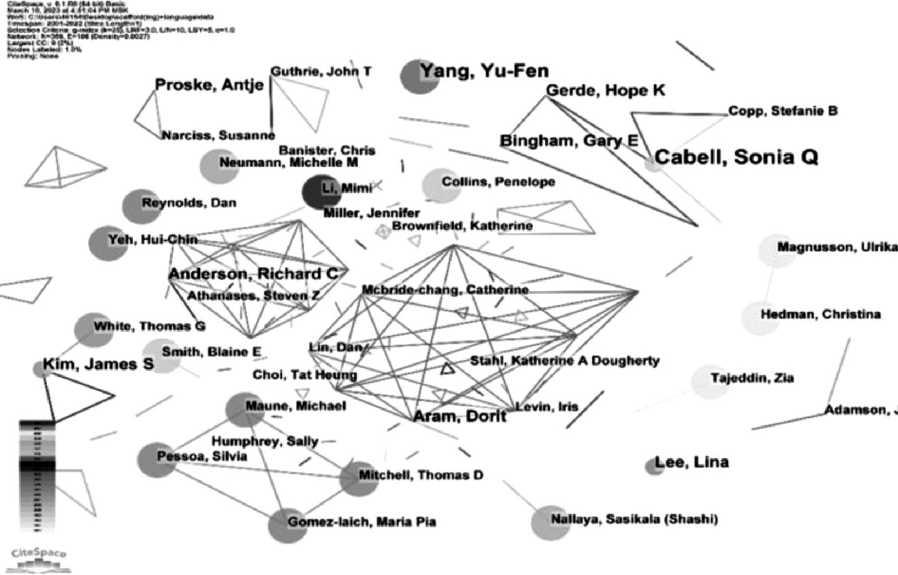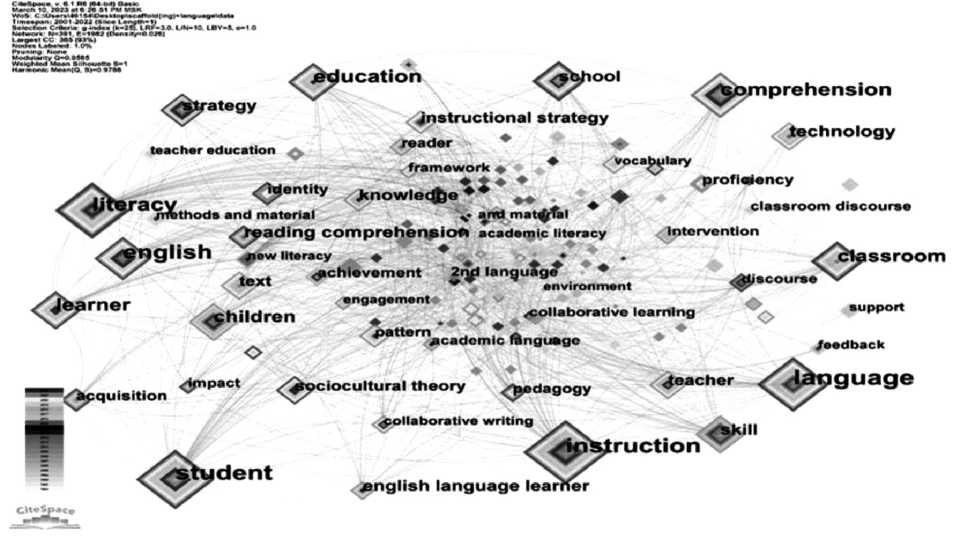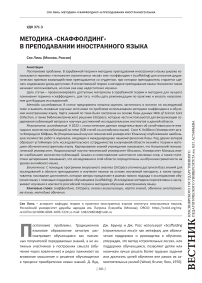Методика «скаффолдинг» в преподавании иностранного языка
Автор: Линь С.
Журнал: Вестник Красноярского государственного педагогического университета им. В.П. Астафьева @vestnik-kspu
Рубрика: Научный дебют
Статья в выпуске: 2 (68), 2024 года.
Бесплатный доступ
Постановка проблемы. В зарубежной теории и методике преподавания иностранного языка широко используются термины «технология строительных лесов» или «скаффолдинг» (scaffolding) для описания дидактических приемов взаимодействия преподавателя со студентом, при котором преподаватель старается сделать содержание урока доступнее. В отечественной теории и методике преподавания языка технология также начинает использоваться, но пока она еще недостаточно изучена. Цель статьи - проанализировать доступные материалы в зарубежной теории и методике для лучшего понимания термина «скаффолдинг», для того, чтобы дать рекомендации по практике и указать направление для будущих исследований.
Скаффолдинг, citespace, анализ визуализации, карта знаний, обучение иностранному языку, методика обучения
Короткий адрес: https://sciup.org/144163125
IDR: 144163125 | УДК: 371.3
Текст научной статьи Методика «скаффолдинг» в преподавании иностранного языка
Сяо Линь – аспирант кафедры теории и практики иностранных языков института иностранных языков, Российский университет дружбы народов им. Патриса Лумумбы (Москва); ORCID: ; e-mail:
П остановка проблемы . Традиционное языковое образование зачастую рассматривает обучающихся как пассивных получателей передаваемых знаний, а не активных участников в построении смысла (обучение через вовлечение) и редко принимает во внимание мышление и решения обучающегося в процессе приобретения новых знаний. Д. Вуд,
Дж. Брунер и Дж. Росс используют «Scaffolding (строительныt леса)» как метафору для обозначения поддержки и руководства в обучении, утверждая, что метод «строительных лесов», или поддержки обучающихся, позволяет детям или новичкам лучше решать более трудные задания или достигать целей обучения вне рамок их самостоятельных усилий [Wood, Bruner, Ross, 1976].

Репетитор или преподаватель оказывает поддержку только в самые сложные моменты выполнения задания, чтобы помочь ученику выполнить упражнения, которые выше его возможностей на текущем этапе обучения. Поддержка прекращается, когда ученик способен выполнить задачу самостоятельно.
По мере развития концепции «scaffolding» ее более широкое толкование также разрабатывалось как взаимодействие между учителями и учащимися в классе, структура уроков, стратегия обучения, средства обучения и т.д. Методика применяется и адаптируется исследователями для конкретной области изучения языка. Например, Дж. Брунер [Bruner, 1978] утверждает, что в языковом образовании учащиеся могут самостоятельно находить и решать языковые задачи с помощью методики поддержки (scaffolding). В этой модели через развитие самостоятельного изучения языка, помощь преподавателя и учебную деятельность обучающиеся приобретают новые навыки в среде, где более опытные наставники обеспечивают поддержку, необходимую для выполнения незнакомых задач. В процессе обучения новые знания, умения и навыки постепенно усваиваются учащимися, так что в конечном итоге они могут выполнять подобные задачи самостоятельно. Klingner и другие исследователи рассматривают использование скаффолдинга для обратной связи и исправления ошибок в изучении и преподавании второго языка [Aljaafreh, Lantolf, 1994; Klingner, Vaughn, 2000; Ohta, 2000]. Скаффолдинг также работает как эффективный метод, разработанный для применения в обучении основам грамматики иностранного языка [Lee, Muncie, 2006; Palincsar, Brown, 1984]. Определение «scaffolding» является результатом сочетания эмпирических исследований и выводов теоретических работ, а также разработки новых педагогических методов. В данной работе будут рассмотрены ключевые тенденции в преподавании и обучении с помощью «scaffolding» с точки зрения библиометрического и предметного анализа литературы в основной базе данных Web of Science с помощью программного обеспечения CiteSpace. Задача работы – создать обзор литературы по скаффолдингу, чтобы лучше понять преимущества и недостатки этого метода оптимизации преподавания и изучения иностранного языка.
Материалы и методы. К 2022 г. статистические данные свидетельствуют об устойчивом росте ежегодного количества публикаций по теме (508 статей на английском языке). Карта знаний по теме была построена на основе базы данных Web of Science Core Collection , а также с помощью сервиса Google N-Gram и би-блиометрического решения CiteSpace , которые часто используются для визуализации содержания публикаций авторов и научных достижений исследовательских институтов в данной области.
Настоящее исследование проводилось на основе статистического анализа статей из международных журналов, проиндексированных в международных наукометрических базах цитирования. Данные были получены из основной базы Web of Science , а тематический поиск проводился по ключевым словам «scaffolding», лемме «scaffold» в контексте раздела «Language Teaching». Для исследования литературы был выбран период 2001–2022 гг.
На основе полученных 508 достоверно опубликованных статей автором была составлена карта знаний исследований в области языкового образования по теме «scaffolding» с помощью системы CiteSpace , предназначенной для визуализации данных путем картирования.
CiteSpace – это инструмент для создания карт научных знаний, использующий методы визуализации для представления эволюции области знаний на одной карте знаний, а также для демонстрации многих неявных и сложных отношений между единицами знаний или кластерами знаний, таких как сети, структуры, взаимодействия, пересечения, эволюции или деривации, с целью изучения дисциплинарных границ [Чэнь Юэ, Чэнь Чаомэй, Лю Цзэюань и др., 2015].
Анализ частотности термина «скаф-фолдинг» в международных научных изданиях. Анализ тенденций в публикациях, полученных в результате поиска, представлен на рис. 1. Из рис. 1 видно, что частотность публикаций по теме обучения языку на основе подхода «скаффолдинг» колеблется, но показывает

Рис. 1. Частотность статей по теме «скаффолдинг», опубликованных в международных рейтинговых научных изданиях Fig. 1. Frequency of articles on the topic ‘scaffolding’ published in internationally ranked scientific publications
Обзор исследований в данной области позволяет предположить три варианта будущих тенденций в этой области: 1) резкое снижение числа публикаций; 2) стабилизация негативной тенденции в 2023 г., за которой последует устойчивый рост; 3) устойчивый рост с колебаниями годового показателя около 60 статей в дальнейшем. На наш взгляд, наиболее вероятным представляется оптимистичный сценарий 3, так как исследуемая методика хорошо применима в цифровой образовательной среде.
общую тенденцию к росту до 2021 г. Тенденция изменения количества публикаций в год с 2001 по 2012 г. медленная, и на данном этапе исследование находится в зачаточном состоянии. С 2012 по 2019 г. количество публикаций значительно увеличилось. В общей сложности опубликовано 69 работ. График публикационной активности по исследуемой теме достигает пика в 2019 г., что свидетельствует о возрастающем интересе к методике среди международных ученых. Указанная тенденция сохраняется вплоть до настоящего времени.
В период пандемии 2020–2022 гг. наблюдается общее снижение числа публикаций, в 2022 г. объем выпуска научных статей по исследуемой методике снизился на 38 % по сравнению с 2021 г.
Карта знаний по термину «скаффолдинг» в зарубежной теории и методике преподавания языка. Построение карт знаний по теме «скаф-фолдинг» позволяет наглядно оценить наиболее продуктивных авторов научных статей в данной области (рис. 2), а также отразить международные связи научных учреждений, занимающихся темой «скаффолдинг» в обучении иностранному языку (рис. 3).
Всего выявлено 369 ключевых узлов (E = 369). В результате перекрестного анализа и визуали-
зации удалось установить 508 авторов научных статей по заявленной теме, чьи работы были проиндексированы в журналах, входящих в между- народные реферативные базы цитирований. Выявлено 186 устойчивых связей (E = 186), связи между узлами.

Рис. 2. Карта знаний авторов, публикующих научные работы по теме «скаффолдинг» в обучении иностранному языку Fig. 2. Knowledge mapping of authors who publish scientific papers on the topic ‘scaffolding’ in teaching a foreign langauge
Каждый узел на карте представляет автора. Чем темнее узел на представленных иллюстрациях, тем сильнее связь (цитирования) или международное сотрудничество авторов. Размер узлов также отражает частоту их проявления: чем больше шрифт узла, тем чаще автор публикуется по исследуемой теме.
Из рис. 2 видно, что Соня К. Кейбелл (Университет штата Флорида (США)), Ричард К. Митчелл (Университет Брока (Шотландия)), Ричард К. Андерсон (Университет Иллинойса в Урбана-Шампейн (СШA)), Арам Дорит (Тель-Авивский университет (Израиль)) являются наиболее продуктивными авторами по исследуемой теме и образуют устойчивую сеть международного научного взаимодействия.
Китайский ученый Юй-Фэнь Ян (Национальный Юньлиньский университет науки и техно- логий (КНР)) не включен в сети сотрудничества и работает самостоятельно. В целом распределение ученых по вопросам преподавания языка с помощью «scaffolding» довольно разрозненно, в основном это простые совместные работы двух или трех человек, без большого количества тесно связанных между собой сетей исследователей. Большая часть ученых работают в США или КНР.
Анализ по CiteSpace также позволяет оценить интерес к теме в профильных научноисследовательских институтах разных стран. На основе полученных данных можно вывести распределение отдельных аспектов по различным исследованиям, а также сделать обоснованные предположения о наиболее перспективных направлениях применения данной методики.
Наибольшее количество статей, раскрывающих тему «скаффолдинг» в обучении иностранному языку, опубликовали следующие учебные заведения.
-
1. Наньянский технологический университет (Nanyang Technology University).
-
2. Национальный научно-технический университет Юньлинь (National Yunlin University of Science and Technology).
-
3. Университет Монаша (Monash University).
-
4. Университет штата Флорида (Florida State University).
-
5. Университет Гриффита (Griffith University).
С опорой на анализ карты знаний международных связей научных учреждений, занимающихся темой «скаффолдинг» в обучении иностранному языку, можно прийти к выводу о том, что данные учреждения имеют самый большой размер шрифта, что указывает на то, что в них присутствует наибольшая публикационная активность профессиональных исследователей по теме «скаффолдинг». Следовательно, их можно считать лидерами мировой науки в данной области.
Разветвленная сеть сотрудничества с большим количеством институциональных связей была сформирована в КНР. Китайские высшие учебные заведения Наньянский технологический университет и Национальный Юнь-линьский университет науки и технологий можно найти в самом центре карты знаний по теме «скаффолдинг».
Также анализ карт знаний показал, что существует устойчивая и разветвленная сеть сотрудничества между американскими и австралийскими учебными заведениями, такими как Университет штата Флорида, Сиднейский университет, Университет Вандербильта и Гарвардский университет. Существует тесная сеть сотрудничества между учебными заведениями Китая, такими как Гонконгский университет, Фуданьский университет и Китайский университет в Гонконге и т.д. Сеть сотрудничества, центром которой является Наньянский технологический университет в Сингапуре, включает в себя министерство образования и Австралийский национальный университет в Австралии. Сотрудничество между учреждениями носит явно региональный характер, а уровень сотрудничества между учреждениями в разных странах очень низок.
Анализируя большой массив литературы на предмет ключевых слов, частоты встречаемости ключевых слов в определенной области за определенный промежуток времени и ранжируя их в порядке убывания частоты, можно наглядно представить динамику исследований и точки роста исследований в данной области. Карты знаний о ключевых словах получены с помощью CiteSpace . Как следует из рис. 3, имеется 391 узел (N=391) и 1982 связанных линии (E=1982), что указывает на достаточно высокий исследовательский интерес к ключевым словам по теме «scaffolding».
Визуальный анализ ключевых слов с помощью CiteSpace также может помочь при анализе цитирования ключевых слов. На рис. 4 можно отметить наиболее часто цитируемые ключевые слова.
Карты ключевых слов описывают частотность перекрестного цитирования за определенный период, что позволяет в дальнейшем наблюдать за продолжительностью использования ключевых слов, относительным исследо-

Рис. 3. Карты знаний о частотности употребления ключевых слов
Fig. 3. Knowledge mapping on the frequency of keyword usage
Top 15 Keywords with the Strongest Citation Bursts
Рис. 4. Всплеск цитирования ключевых слов Fig. 4. Burst of keyword citations вательским интересом к теме, текущими точками роста исследований и прогнозами будущих направлений исследований. На рис. 4 указывается «Year» (год), в котором ключевое слово появилось; «Begin» (начало) указывает на время появления ключевого слова как точки роста исследовательского интереса; «End» (конец) значит, что ключевое слово перестало привлекать много внимания исследователей; «Strength» (сила) отображает силу присутствия ключевого слова, которая пропорциональна его влиянию [Ли Цзе, Чэнь Чаомэй, 2016]; в годовом диапазоне 2001–2022 гг., часть горизонтальной линии указывает на время появления ключевого слова и его продолжительность, а другая часть – на время, когда ключевое слово стало горячей точкой исследования, и его продолжительность.
Обобщив карты знаний по ключевым словам и рассмотрев их содержание, можно сделать вывод, что ключевые точки роста исследований в области обучения языку в контексте «scaffolding» можно разделить на следующие три: английский язык, грамотность и инструктирование при обучении.
Английский язык – одна из самых популярных тем в обучении иностранным языкам, так как он является языком международного общения. В процессе преподавания английского языка как второго иностранного ученые максимально уточняют содержание и направление исследований, что позволяет составлять подробные карты. В то время как причины для использования стратегий «scaffolding» в курсах чтения EFL (английский как иностранный) включают поддержку метакогнитивной деятельности, когнитивной деятельности, влияние на студентов и содействие вовлеченности, команда Nienke Smit разработала новый инструмент: протокол наблюдения за пониманием чтения на английском языке. Этот новый инструмент фокусируется на роли преподавателя EFL, который помогает студентам перейти от обучения чтению к изучению английского языка через чтение [Smit et al., 2017]. Преподаватели EFL должны признать важность удобочитаемости для критериев отбора учебников и предоставить учащимся доступ к дополнительным вспомогательным материалам [Odo, 2018]. Потребность в английском языке варьируется от университета к университету. Например, Университет Сянгана использует английский язык в качестве средства обучения, чтобы способствовать развитию предметного понимания языка у студентов в Пекине в рамках программы Scaffolding грамотности в академической и третичной среде (SLATE) [Mahboob, 2014].
Навыки грамотности считаются критически важными в общеобразовательных классах средней школы. Обучение грамотности включает в себя навыки человеческого общения, чтения и письма. Миллер утверждает, что необходимо интегрировать стратегии обучения грамотной речи с принципами второго языка, чтобы помочь учащимся понять текст [Miller, 2013]. При обучении грамотности культурные особенности учащихся, стратегии преподавания учителей, домашнее руководство, поддержка современных технологий и поддержка сверстников могут оказать положительное влияние на скорость формирования грамотности учащихся. К примеру, в своем эксперименте «Athanases» преподаватель-экспериментатор сосредоточился на важности использования модели «scaffolding» для задействования культурных и языковых ресурсов студентов в практике преподавания [Athanases, Oliveira de, 2014]. Для учащихся с английским в качестве дополнительного языка в статье Оливейра с соавторами было продемонстрировано, что монолинг-вальные учителя могут развивать навыки использования родного языка учащихся в качестве эффективного инструмента обучения грамотности [Oliveira de et al., 2016].
При домашнем обучении родители могут практиковать письмо, обучая детей пользоваться традиционными инструментами (например, бумагой и карандашом) или планшетами с сенсорным экраном (например, iPad) [Kirova, Jamison, 2018]. Однако учителя часто оказывают больше поддержки, чем необходимо, что может подавлять развитие критического мышления, помогающего в дальнейшем развивать знания в области грамотности [Copp et al., 2023]. В предметных областях, где игра является способом обучения, учителя берут на себя различные роли, чтобы поддержать взаимодействие учащихся и способствовать обучению грамотности, в то время как учащиеся реагируют на это сотрудничеством, творческим самовыражением в устной и письменной форме [Portier et al., 2019]. A. Kirova и N.M. Jamison на практике обнаружили, что более способные учащиеся использовали различные стратегии и методы, чтобы помочь своим
сверстникам в создании грамотных текстов при взаимном обучении [Kirova, Jamison, 2018].
Проблемы, с которыми сталкиваются изучающие второй язык в различных контекстах преподавания и обучения, отличаются и поэтому требуют разных эффективных стратегий вмешательства преподавателей для поддержки обучающихся по методу «scaffolding».
В эксперименте, проведенном в Южной Африке, для повышения уровня чтения учащихся использовались процедуры прямого обучения в сочетании с техникой «scaffold для чтения» [Staden van, 2011]. Упражнения, направленные на развитие метапознания читателя, включая визуальные подсказки и подсказки учителя, повышают уверенность учащихся в себе, создавая эффект узнавания [Pratt, Urbanowski, 2016]. Учащиеся, получающие интегрированное обучение чтению и науке с помощью «scaffolding», добились больших успехов в понимании прочитанного и использовании инструкции преподавателя, чем учащиеся традиционных учебных классов без такой поддержки [Lutz et al., 2006]. Исследования показали, что программы экстенсивного чтения с помощью «scaffold» экспертов-читателей могут быть весьма эффективны [Turner, 2012]. Поддержка преподавателя и одновременное взаимное обучение в группах со сверстниками может способствовать развитию грамотности и языковых навыков учащихся [Xu et al., 2022].
Заключение . Модель методики с помощью «scaffolding» играет важную роль в реформировании модели образования, методологии и дизайна обучения в аудиториях. Практическая значимость модели обучения с помощью скаффол-динга заключается в том, что она проходит через весь учебный процесс и затрагивает все аспекты преподавания и обучения. Постепенное углубление исследования моделей обучения с использованием скаффолдов имеет большое значение для расширения исследований международных моделей обучения.
В зарубежной теории и методике преподавания английского языка наблюдается общая тенденция к росту числа публикаций в «scaffolding».
Интерес международного научного сообщества в сфере педагогики к данной методике, а также возрастающая публикационная активность позволяют предположить, что исследуемый дидактический прием находит все более широкое применение.
Стоит отметить, что основные сообщества исследователей работают достаточно изолированно друг от друга. Существует региональная специализация учреждений и педагогических направлений. В результате наблюдается низкая частота сотрудничества между продуктивными авторами в КНР и США, что не способствует расширению спектра цитируемых исследований по данной проблематике. В ближайшее время трудно ожидать, что ключевые научные институты смогут преодолеть существующие ограничения, чтобы внести больший вклад в исследования в этой области.
Исследования в области преподавания языка в контексте «scaffolding» сосредоточены на обучении английскому языку (например, чтению, говорению, письму). Английский язык как международный является вторым языком по выбору в большинстве стран. Для изучающих английский язык как иностранный ключевое значение в обучении имеет то, как учителя используют модель «scaffolding» для координации групповых и индивидуальных активностей. В языковом образовании понятия, связанные с грамотностью, учебными навыками, инструкциями обучения и технологическими материалами, в определенной степени взаимосвязаны.
В заключение стоит отметить, что данная работа ограничена извлечением и анализом публикаций только в рамках основной базы данных Web of Science. Следовательно, в статье присутствуют неполные источники анализа данных. Тем не менее основная база Web of Science как наиболее часто используемая база данных для наукометрических исследований в значительной степени авторитетна и репрезентативна, чтобы сделать вывод об актуальности рассматриваемой методики «скаффолдинг». С помощью визуализации информации были определены основные тенденции и направления дальнейшего развития авторитетных авторов и учреждений в области изучения преподавания иностранного (английского) языка. Методика «скаффолдинг» перспек- тивна и заслуживает изучения в контексте российской теории и методики преподавания иностранного языка.
Список литературы Методика «скаффолдинг» в преподавании иностранного языка
- Ли Цзе, Чэнь Чаомэй. CiteSpace кэ цзи вэнь бэнь ва цзие цзи кэ ши хуа [CiteSpace добыча и визуализация научных текстов] // Пекин: шоу ду цзин цзи мао и да сюе чу бан шэ [Пекин: Изд-во Столичного университета экономики и бизнеса](на китайском языке; 李杰,陈超美.CiteSpace 科技文本挖掘及可视化 [M]. 北京: 首都经济贸易大学出版社,2016).
- Чэнь Юэ, Чэнь Чаомэй, Лю Цзэюань и др. Citespace чжи ши ту бу дэ фань фа кон нэнь [Методологические особенности «Citespace» карты знаний] // ко сюэ иан цзию [Научные исследования], 2015, 33 (2):242–253 (на китайском языке; 陈悦,陈超美,刘则渊等,Citespace知识图谱的方法功能(J),科学学研究,2015,33 (2):242–253).
- Aljaafreh, A., & Lantolf, J.P. (1994). Negative feedback as regulation and second language learning in the zone of proximal development. The Modern Language Journal, 78 (4), 465–483.
- Athanases, S.Z., & de Oliveira, L.C. (2014). Scaffolding versus routine support for Latina youth in an urban school: Tensions in building toward disciplinary literacy. Journal of Literacy Research, 46 (2), 263–299.
- Bruner, J. (1978). The role of dialogue in language acquisition. The Child’s Conception of Language, 2 (3), 241–256.
- Copp, S.B., Cabell, S.Q., Gabas, C., Slik, D., & Todd, J. (2023). The rising star scaffolding guide: Supporting young children’s early spelling skills. The Reading Teacher, 76 (4), 380–389.
- Johnson, E. (2021). Contingency in context: A Study of exemplary reading teachers’ use of planned scaffolds in secondary English classes with emergent bilinguals. Reading & Writing Quarterly, 37 (3), 260–278.
- Kirova, A., & Jamison, N.M. (2018). Peer scaffolding techniques and approaches in preschool children’s multiliteracy practices with iPads. Journal of Early Childhood Research, 16 (3), 245–257.
- Klingner, J.K. & Vaughn, S. (2000). The helping behaviors of fifth graders while using collaborative strategic reading during ESL content classes. TESOL Quarterly, 34, 69–98.
- Lee, S-H. & Muncie, J. (2006). From receptive to productive: Improving ESL learners’ use of vocabulary in a postreading composition task. TESOL Quarterly, 40, 295–320.
- Lutz, S.L., Guthrie, J.T., & Davis, M.H. (2006). Scaffolding for engagement in elementary school reading instruction. The Journal of Educational Research, 100 (1), 3–20.
- Mahboob, A. (2014). Meeting the challenges of English-medium higher education in Hong Kong. International Review of Applied Linguistics in Language Teaching, 52 (2), 183–203.
- Miller, J. (2013). Communicative literacy pedagogy: Engaging EAL students in reading comprehension. English in Australia, 48 (1), 36–45.
- Odo, D.M. (2018). A comparison of readability and understandability in second language acquisition textbooks for pre-service EFL teachers. Journal of Asia TEFL, 15 (3).
- Ohta, A.S. (2000). Rethinking interaction in SLA: developmentally appropriate assistance in the zone of proximal development and the acquisition of L2 grammar. In: J.P. Lantolf (Ed.), Sociocutural theory and second language learning (pp. 51–78). New York: Oxford University Press.
- Oliveira de, L.C., Gilmetdinova, A., & Pelaez-Morales, C. (2016). The use of Spanish by a monolingual kindergarten teacher to support English language learners. Language and Education, 30 (1), 22–42.
- Palincsar, A.S., & Brown, A.L. (1984). Reciprocal teaching of comprehension-fostering and comprehension-monitoring activities. Cognition and Instruction, 1, 117–175.
- Peercy, M.M. (2011). Preparing English language learners for the mainstream: Academic language and literacy practices in two junior high school ESL classrooms. Reading & Writing Quarterly, 27 (4), 324–362.
- Portier, C., Friedrich, N., & Peterson, S.S. (2019). Play (ful) pedagogical practices for creative collaborative literacy. The Reading Teacher, 73 (1), 17–27.
- Pratt, S.M., & Urbanowski, M. (2016). Teaching early readers to self-monitor and self-correct. The Reading Teacher, 69 (5), 559–567.
- Smit, N., Grift van de, W., Bot de, K., & Jansen, E. (2017). A classroom observation tool for scaffolding reading comprehension. System, 65, 117–129.
- Staden van, A. (2011). Put reading first: Positive effects of direct instruction and scaffolding for ESL learners struggling with reading. Perspectives in Education, 29 (4), 10–21.
- Turner, F.D. (2012). Increasing word recognition with racially diverse second-grade students using fluency-oriented reading approaches. The Journal of Educational Research, 105 (4), 264–276.
- Wood, D., Bruner, J.S., & Ross, G. (1976) The Role of tutoring in problem solving’. Journal of Child Psychology and Psychiatry, 17, 90.
- Xu, Y., Chen, C.-C., Spence, C., Washington-Nortey, M., Zhang, F., & Brown, A. (2022). Supporting young Spanish speaking English learners through teacher scaffolding and reciprocal peer tutoring. Early Child Development and Care, 192 (8), 1324–1336.


